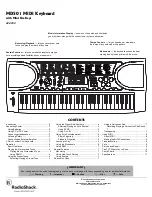
5
5. To change the tempo, repeatedly press
TEMPO UP
or
TEMPO DOWN
. The current
tempo setting appears.
±
6. Play the keyboard along with the auto-
rhythm.
7. To select a different rhythm, repeat
Steps 1 and 2.
8. To stop the auto-rhythm, press
START/
STOP
again.
7UKPI
"
5;0%
This feature lets you synchronize the start of
an auto-rhythm with the beginning of your
music.
After you select and enter an auto-rhythm,
press
SYNC/FILL-IN
. The black dots above
the metronome flash to show the keyboard is
in a standby mode.
Begin playing the keyboard. The keyboard
automatically begins to play the rhythm when
you press any key.
7UKPI
"
(+..
/
+0
This feature lets you insert a short (1- to 2-
measure) variation in the beat pattern of a
selected auto-rhythm.
Simply press
SYNC/FILL-IN
while the auto-
rhythm is playing. The keyboard inserts a
variation, then the original rhythm
automatically resumes at the end of the
current measure. Or, to insert a longer
variation, hold down
SYNC/FILL-IN
. The
keyboard plays the variation until you release
SYNC/FILL-IN
.
7
5+0)
"
#
761
"
#
%%1/2#0+/'06
The 19 keys on the left side of the keyboard
with note labels above them are called
accompaniment keys. The accompaniment
keys you press determine the type of chord
that plays.
±
You can set the keyboard to play with no
accompaniment or two different types of auto
accompaniment using the accompaniment
keys.
• NORMAL — Normal mode. Chords are
turned off in this mode (but you can
select tone and rhythm).
• S.FINGER
— Single Fingering mode.
This mode lets you play chords on the
accompaniment keys using standard
chord formations (see “Single
Fingering”).
• FINGERED — Standard Fingering
mode. This mode lets you play chords
on the accompaniment keys using chord
formations of from three or more notes.
The chord name appears on the display.
The number of keys you press
determines the type of chord that plays
(see “Standard Fingering” on Page 6).
Your keyboard defaults to the Normal mode.
Follow the steps under “Single Fingering” or
“Standard Fingering” to set it to an
accompaniment mode.
5KPING
"
(KPIGTKPI
1. Set
POWER
to
ON
.
2. Repeatedly press
CHORD
until a black
dot appears next to S.FINGER on the
left side of the display.
3. Press
RHYTHM
.
4. Enter a two-digit auto-rhythm number.
5. To start the auto-rhythm before the auto
accompaniment, press
START/STOP
.
Or, to synchronize the start of the
selected auto-rhythm with your
accompaniment, press
SYNC/FILL-IN
.
6. Begin the accompaniment at the desired
interval by pressing the desired
accompaniment key(s).
To play a melody along with the
accompaniment, press any key(s) to the
right of the accompaniment keys.
7. Adjust
TEMPO
and
VOLUME
to the
desired levels.
8. To change chords without interrupting
the rhythm, simply press the auto
accompaniment key(s) required to form
the new chord. The name of the chord
appears.
9. To stop auto accompaniment but not the
auto-rhythm, repeatedly press
CHORD
until the black dot appears next to
NORMAL on the display. Or, to stop auto
accompaniment and the auto-rhythm,
press
START/STOP
.
±
"
016'
"
±
"
Selecting/Playing an Auto-Rhythm
•
You can adjust the tempo to play an auto-
rhythm from 40 to 240 beats per minute.
•
To reset the tempo to its default (original)
speed, press TEMPO UP and TEMPO
DOWN at the same time.
Using Auto Accompaniment
See “Chord Charts” on Page 10 for a list of all
the chords you can play on your keyboard.












